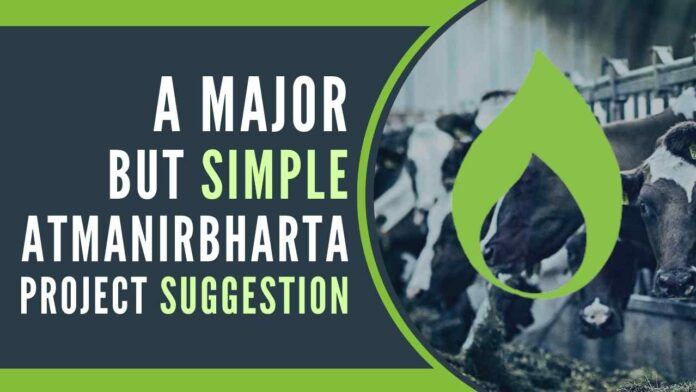
Biogas system: Low-hanging fruit scheme with multiple benefits
Implementing this Project can save up to Rs.16,200 crores of foreign exchange annually for the government, about Rs.2,700 per year per rural family for families owning cows/ cattle. And the government needs to spend no money on this scheme unless it wants to subsidize the cost to the beneficiaries in some form.
LPG costs about Rs.900 (at today’s cost) to the domestic consumer.
Under the Pradhan Mantri Ujjwala Yojana (PMUY), 5 crore women living below the poverty line (BPL) were provided concessional LPG connections and it has since been extended to 1 crore more families. The beneficiaries pay about Rs.900 per cylinder, and at 6 cylinders a year, the cost per family works out to Rs.5,400 annually.
The government imports LPG at about 50% of this cost (say, Rs.450), and value additions like logistics, filling, delivery, taxes, etc add up to Rs.450 more. So, the import component is about Rs.2,700/ family. For 6 crore families, this works out to Rs.16,200 crores annually, which is the forex outgo for the government.
If there is a way this can be brought under the Atmanirbharta Bharat scheme, and the gas delivered without incurring forex, the government will save forex of Rs.16,200 crores annually.
If, in addition, the poor families can be made to spend only about Rs.2,700 per year towards cooking gas, the families will also benefit immensely.
So this Project envisages Rs.16,200 annual savings in forex for the government and Rs.2,700 per family annually to the beneficiary families. The government, with access to more accurate data, can find-tune these figures.
The biogas systems have long been a cost-effective alternative to meet the cooking fuel needs of the rural poor, not only in India but across the world. The input is cow dung and the output is biogas, connected directly to the biogas stove in the nearby kitchen. It also produces the byproduct of cow dung slurry of almost the same quantity as the cow dung, which is excellent natural organic manure for farms.
“Brick and mortar” and plastic made of biogas systems have been the most common, but difficult to build/ buy, transport, install and maintain, and have been often costly. When such systems become dysfunctional, the rural poor have no easy way of repairing and getting them back in operation. Hence, there are lots of abandoned biogas systems across India.
Many state governments have offered subsidies to make them affordable, but this has not increased the number of biogas installations substantially, which is why the government had to come up with the PMUY program. If biogas systems were successful, the rural poor would not have needed the PMUY scheme.
The author has had a good experience with good bag-type biogas systems and they are fairly maintenance-free. The systems of 1 m3/ day biogas capacity will require cow dung from 2 cows. The biogas produced will be enough for the cooking needs of a family of about 5. This system can be easily manufactured within each state and sold at around Rs.10,000, including free insurance and free maintenance for 5 years. The stoves are available at around Rs.1,000. Each system can be installed locally using local plumbers at around Rs.1,000. So, the total cost including maintenance and insurance can be kept within Rs.12,000.
A 1 m3/day biogas system will give about 12 LPG cylinders equivalent biogas per year, not just 6 as in the case of LPG. So, the beneficiary family can do a lot more cooking/ heating with the biogas system than it can with the LPG cylinder.
If the systems can be given to the beneficiary families through bank loans, the monthly payout will be less than Rs.225, which is about 25% of the cost of the LPG cylinder. And there are no consumables or operating costs.
The government can get the necessary bank loan for the beneficiaries, and help them pay the banks back from monthly collections from the beneficiary families. And the project can be operationalized through some kind of cooperative organization, or even linked to ration cards.
The additional benefits of the biogas system are:
- Biogas is safer to operate than LPG, as biogas is not under pressure.
- The biogas system will reduce GHGs (greenhouse gases) emitted by cow dung substantially, giving our government additional bargaining power in climate change talks.
- Reject from biogas system is pathogen-free organic manure rich in NPK, better than raw cow dung (which has pathogens), and far better than chemical fertilizers. The slurry can be used as manure directly or after composting/ vermicomposting.
- It will lead to cleaner villages, contributing to Swachh Bharat Mission.
- It will generate a few thousand rural manufacturing jobs to make these biogas systems and a few lakh rural jobs in manufacturing the systems, and for artisans to connect and maintain these systems.
In sum, this is a low-hanging fruit scheme with multiple benefits, with almost no downside, no financial commitment from the government, and also earning the goodwill of the beneficiary families.
Note:
1. Text in Blue points to additional data on the topic.
2. The views expressed here are those of the author and do not necessarily represent or reflect the views of PGurus.
PGurus is now on Telegram. Click here to join our channel and stay updated with all the latest news and views
For all the latest updates, download PGurus App.
- How BJP can get 33%+ vote share in TN - April 1, 2024
- A transparent, equitable electoral funding alternative - March 19, 2024
- How TN BJP can come to No. 1 or No. 2 in 2024 LS polls - January 11, 2024







